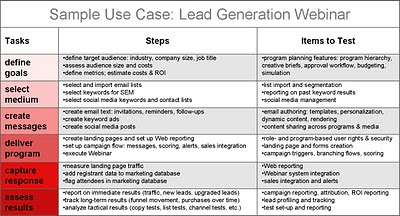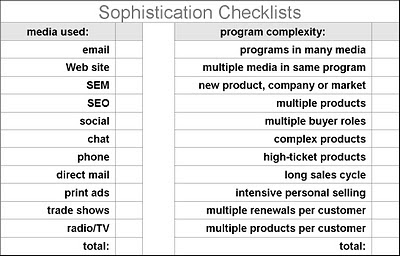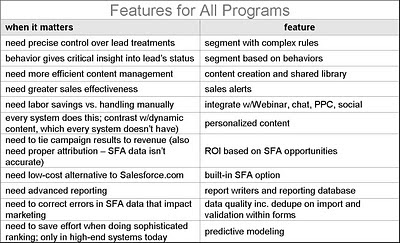Summary: LoopFuse has launched a free entry-level version of its marketing automation system. It's one example of how vendors are now competing to attract new users. Only the winners will survive industry consolidation, which may be here sooner than you think.
LoopFuse today promised to “transform” the marketing automation industry by offering a free version of its system. Although LoopFuse and others already provide free trials, this is indeed different: while most free trials expire after 30 days and often have limited functionality, LoopFuse’s FreeView can be used for as long as you like and provides pretty much the same features as the paid version of the system. The critical constraint is that volume is limited to 2,500 prospect names, 5,000 emails and 100,000 page views per month. In practice, this means that only very small companies will actually be able to use the free system as their primary long-term marketing system.
LoopFuse knows that, of course. When they briefed me last week, they said the main purpose of the new system is really to entice trial among companies just starting with marketing automation. They’ll make their money when users see the value they gain and pay for higher volumes and add-on features.
Personally, I’d argue that the really significant news out of LoopFuse is their newly tiered pricing structure. The entry point of $350 per month (for up to 10,000 prospects with unlimited emails and page views) is much lower than the $1,000 to $2,000 starting price of most full-function marketing automation systems. Prices at higher volumes are also much lower than competitors. This will put substantial pricing pressure on vendors who, in many cases, are already struggling to reach sustainable margins.
Here’s where the free system comes back into play. To make a free product viable, LoopFuse needed to engineer as much cost as possible out of the entire client life cycle. This means it had to be possible for clients to purchase and configure the system, learn how to use it and resolve support issues with next to no involvement by LoopFuse staff. Once this was accomplished, LoopFuse was in a position to charge lower fees to its paying clients as well. Other vendors – notably Pardot – have followed a similar cost-removal strategy. But LoopFuse may have been more focused than anyone else.
This doesn’t mean that LoopFuse’s success is guaranteed. Other vendors have similar price points for the small business market (see my list of demand generation vendors) although I suspect their internal costs are higher.
More important, price is just one factor in picking a system. Features, ease of use, and support from the vendor and business partners are usually (and rightly) the main considerations. The free product should increase the number of companies that try LoopFuse first, which will gain it paying customers down the road. But I think that most buyers will recognize that they are likely to stay with their first system and conduct a careful evaluation before they start.
For evidence that a free entry-level product does not automatically drive out higher priced systems, consider the hosted CRM market. Salesforce.com easily dominates despite the presence of surprisingly capable free products like ZohoCRM and FreeCRM .
Whatever the result for LoopFuse, the new offering is part of a larger pattern within the industry. Marketing automation (more precisely, B2B marketing automation) has now passed beyond the pioneer stage where fundamentally different approaches compete for acceptance. At this point, we all pretty much know what a marketing automation system does and, truth be told, the major systems are functionally quite similar.
Competition now shifts from building a technically better system to surviving the inevitable industry consolidation. This requires finding ways to attract masses of new customers as they enter the market.
LoopFuse’s price-driven approach is one such strategy. But many vendors have recently taken others:
- Eloqua, Silverpop, True Influence and at least one other vendor I can’t name are planning new interfaces that they believe will substantially improve ease of use, which they see as the critical barrier blocking many potential buyers. I’m skeptical that truly radical improvements are possible but am certainly eager to see what they come up with.
- LeadLife has embedded best practice hints throughout its system, another way to support adoption by users who lack marketing automation knowledge.
- Infusionsoft has repositioned itself as “email 2.0” rather than marketing automation. They believe this makes it easier for their target customers (under 25 employees) to see them as the next logical step beyond standard email.
- Genius.com added a new Demand Generation edition that falls between its basic Email Marketing and full-blown Marketing Automation products. This is another way of easing the transition from basic email marketing.
- LeadForce1 launched a solution that uses advanced text analysis to measure user intent, and thus provide much better guidance to salespeople than conventional behavioral analysis. Although their approach is based on superior technology, it's still a way to attract customers by offering radically greater value than competitors.
- Marketo now calls itself a “the revenue cycle management company”, giving equal public weight to lead management, sales insight and analytics. They still haven’t briefed me on this or their features to support large enterprises, but they seem to be seeking larger, more sophisticated clients who will presumably provide higher profit margins. Given how many other vendors are targeting small businesses, this certainly makes sense. But Marketo will also find itself competing with established marketing automation vendors like Aprimo, Neolane and Unica. who are entering this market from a different direction. It will also be competing with Eloqua, Silverpop and, perhaps most dangerously, the Market2Lead technology recently purchased by Oracle.
The Market2Lead-Oracle deal raises the other major question facing marketing automation vendors: what role CRM vendors will play? In addition to Oracle, CDC Software (owner of Pivotal CRM and MarketFirst) recently invested in Marketbright.
Of course, the really big question is whether Salesforce.com will make a similar move. There have been off-and-on rumors along those lines for months, followed by stout (if not necessarily credible) denial from Salesforce.com that it has any interest in that direction. I’ve tended to take them at their word, but Oracle and Salesforce.com are blood rivals, so Oracle’s move could easily prompt a Salesforce.com reaction.
Oddly enough, no seems to consider whether Microsoft will enter the game. That's surely a possibility, and would move towards a certainty if its two big on-demand CRM rivals both added marketing automation products. We might even see Google and Intuit participate: both already sell to small business marketers.
My fundamental conclusion is that the B2B marketing automation industry is about to enter the long-predicted stage of vendor consolidation, and that this will move quite quickly. The survivors will serve particular market segments: primarily small vs. large businesses, plus possibly some vertical industry specialization. The window for new entrants is rapidly closing, so any new player will need a major differentiator that creates a clear advantage and distinct identity.
LoopFuse today promised to “transform” the marketing automation industry by offering a free version of its system. Although LoopFuse and others already provide free trials, this is indeed different: while most free trials expire after 30 days and often have limited functionality, LoopFuse’s FreeView can be used for as long as you like and provides pretty much the same features as the paid version of the system. The critical constraint is that volume is limited to 2,500 prospect names, 5,000 emails and 100,000 page views per month. In practice, this means that only very small companies will actually be able to use the free system as their primary long-term marketing system.
LoopFuse knows that, of course. When they briefed me last week, they said the main purpose of the new system is really to entice trial among companies just starting with marketing automation. They’ll make their money when users see the value they gain and pay for higher volumes and add-on features.
Personally, I’d argue that the really significant news out of LoopFuse is their newly tiered pricing structure. The entry point of $350 per month (for up to 10,000 prospects with unlimited emails and page views) is much lower than the $1,000 to $2,000 starting price of most full-function marketing automation systems. Prices at higher volumes are also much lower than competitors. This will put substantial pricing pressure on vendors who, in many cases, are already struggling to reach sustainable margins.
Here’s where the free system comes back into play. To make a free product viable, LoopFuse needed to engineer as much cost as possible out of the entire client life cycle. This means it had to be possible for clients to purchase and configure the system, learn how to use it and resolve support issues with next to no involvement by LoopFuse staff. Once this was accomplished, LoopFuse was in a position to charge lower fees to its paying clients as well. Other vendors – notably Pardot – have followed a similar cost-removal strategy. But LoopFuse may have been more focused than anyone else.
This doesn’t mean that LoopFuse’s success is guaranteed. Other vendors have similar price points for the small business market (see my list of demand generation vendors) although I suspect their internal costs are higher.
More important, price is just one factor in picking a system. Features, ease of use, and support from the vendor and business partners are usually (and rightly) the main considerations. The free product should increase the number of companies that try LoopFuse first, which will gain it paying customers down the road. But I think that most buyers will recognize that they are likely to stay with their first system and conduct a careful evaluation before they start.
For evidence that a free entry-level product does not automatically drive out higher priced systems, consider the hosted CRM market. Salesforce.com easily dominates despite the presence of surprisingly capable free products like ZohoCRM and FreeCRM .
Whatever the result for LoopFuse, the new offering is part of a larger pattern within the industry. Marketing automation (more precisely, B2B marketing automation) has now passed beyond the pioneer stage where fundamentally different approaches compete for acceptance. At this point, we all pretty much know what a marketing automation system does and, truth be told, the major systems are functionally quite similar.
Competition now shifts from building a technically better system to surviving the inevitable industry consolidation. This requires finding ways to attract masses of new customers as they enter the market.
LoopFuse’s price-driven approach is one such strategy. But many vendors have recently taken others:
- Eloqua, Silverpop, True Influence and at least one other vendor I can’t name are planning new interfaces that they believe will substantially improve ease of use, which they see as the critical barrier blocking many potential buyers. I’m skeptical that truly radical improvements are possible but am certainly eager to see what they come up with.
- LeadLife has embedded best practice hints throughout its system, another way to support adoption by users who lack marketing automation knowledge.
- Infusionsoft has repositioned itself as “email 2.0” rather than marketing automation. They believe this makes it easier for their target customers (under 25 employees) to see them as the next logical step beyond standard email.
- Genius.com added a new Demand Generation edition that falls between its basic Email Marketing and full-blown Marketing Automation products. This is another way of easing the transition from basic email marketing.
- LeadForce1 launched a solution that uses advanced text analysis to measure user intent, and thus provide much better guidance to salespeople than conventional behavioral analysis. Although their approach is based on superior technology, it's still a way to attract customers by offering radically greater value than competitors.
- Marketo now calls itself a “the revenue cycle management company”, giving equal public weight to lead management, sales insight and analytics. They still haven’t briefed me on this or their features to support large enterprises, but they seem to be seeking larger, more sophisticated clients who will presumably provide higher profit margins. Given how many other vendors are targeting small businesses, this certainly makes sense. But Marketo will also find itself competing with established marketing automation vendors like Aprimo, Neolane and Unica. who are entering this market from a different direction. It will also be competing with Eloqua, Silverpop and, perhaps most dangerously, the Market2Lead technology recently purchased by Oracle.
The Market2Lead-Oracle deal raises the other major question facing marketing automation vendors: what role CRM vendors will play? In addition to Oracle, CDC Software (owner of Pivotal CRM and MarketFirst) recently invested in Marketbright.
Of course, the really big question is whether Salesforce.com will make a similar move. There have been off-and-on rumors along those lines for months, followed by stout (if not necessarily credible) denial from Salesforce.com that it has any interest in that direction. I’ve tended to take them at their word, but Oracle and Salesforce.com are blood rivals, so Oracle’s move could easily prompt a Salesforce.com reaction.
Oddly enough, no seems to consider whether Microsoft will enter the game. That's surely a possibility, and would move towards a certainty if its two big on-demand CRM rivals both added marketing automation products. We might even see Google and Intuit participate: both already sell to small business marketers.
My fundamental conclusion is that the B2B marketing automation industry is about to enter the long-predicted stage of vendor consolidation, and that this will move quite quickly. The survivors will serve particular market segments: primarily small vs. large businesses, plus possibly some vertical industry specialization. The window for new entrants is rapidly closing, so any new player will need a major differentiator that creates a clear advantage and distinct identity.














